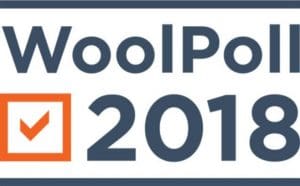 WOOL growers have requested scrutineers be appointed to oversee a 2018 WoolPoll vote recount after Australian Wool Innovation announced the ballot will go to a preference count for the first time.
WOOL growers have requested scrutineers be appointed to oversee a 2018 WoolPoll vote recount after Australian Wool Innovation announced the ballot will go to a preference count for the first time.
None of the options put to wool growers – zero, 1.5 percent, 2pc, 2.5pc or 3pc — received the required 50pc majority on the first count.
AWI today said it had been advised by the WoolPoll returning officer, Link Market Services, that the vote counts for a 1.5pc and for a 2pc levy were very close, with the counting of preferences needed to determine the final outcome.
AWI chief executive officer Stuart McCullough said the company was seeking additional independent advice from LMS and the Department of Agriculture and Water Resources to ensure the process was rigorous.
However, the Australian Wool Growers Association this morning called for AWI to immediately appoint scrutineers from among WoolPoll Panel members after other AWI correspondence declared the WoolPoll regulations relating to preferential vote counting were “actually rather ambiguous”.
AWGA has requested that AWI immediately appoint two panel members with scrutineering experience – which could include AWGA director Rob Ingram and WoolProducers Australia vice president Ed Storey – to oversee a recount of preferenced and non-preferenced WoolPoll votes.
No ambiguity in WoolPoll regulations says AWGA

AWGA director Martin Oppenheimer
In an email to AWI Industry Consultative Committee members, AWI corporate affairs manager Emma Gittoes said the WoolPoll regulations outline the procedures for the preferential system under clause 18 (3)(a-c).
“Upon a review of these; however, and when it has come time to implement the count, they are actually rather ambiguous.
“Link Market Services have only one other client with a preferential voting system, and like AWI, have never had to use the preferential system as one result has always received a 50pc majority,” she wrote.
“AWI are currently seeking advice from Link Market Services and DAWR on the process to be used to count the preferences.”
AWGA director Martin Oppenheimer said the association has had legal advice indicating there is no ambiguity in the WoolPoll regulations, but there is concern that AWI might seek an interpretation of the regulations that allowed non-preferenced votes for the 2.5pc and 3pc options to be applied in the 2pc column or tally.
AWI has lobbied to continue the current 2pc levy; however, industry bodies, including AWGA and WoolProducers Australia are seeking a 1.5pc levy for the 2019-2022 WoolPoll period.
Littleproud notified as WoolPoll Panel meeting called
The office of the Minister for Agriculture and Water Resources David Littleproud and his department have also been notified of AWGA’s concerns about preference counting and a meeting of the WoolPoll Panel has been called for tomorrow.
Mr Oppenheimer said “reading between the lines” there is concern that AWI might be trying to “pull in” or have included in the 2pc option tally the 2.5pc or 3pc levy votes that weren’t preferenced.
“That is outside the regulations – if your vote isn’t preferenced and it is in the lowest pile then it extinguishes.
“We don’t know, we are guessing, but we need scrutineers in there to see the numbers and see how it is all going,” he said.
“It just seems that they (AWI) are trying to fudge it and change the rules half-way through the counting.”
Mr Storey said he did not have enough information to know if scrutineers were warranted, but he did not believe the WoolPoll regulations were ambiguous on preferential vote counting.
“As far as I know there is no ambiguity, either in the regulations or the optional preferential voting system; it is quite clear.
“It is certainly not a surprise to me that they have gone to preferences this time, I thought that was inevitable.
“I do have faith in Link Market Services at this point.”
On the WoolPoll ballot paper, shareholders were required to place the number 1 in the box of their first preference, but they could also complete their paper by placing numbers in the remaining four boxes in order of their preferences, ie. 2, 3, 4 and 5, with 5 being their last preference.
Votes in WoolPoll 2018 were to be counted using an optional preferential voting system to ensure the outcome satisfies the greatest number of levy payers. This means that, if none of the five levy rates achieves 50pc or more first preference votes, levy payers who voted for the least preferred option will have their votes allocated to their second preferences. Reallocating preferences continues until one of the levy rates reaches a majority of votes counted.
DAWR also says no ambiguity in WoolPoll Regulations
A DAWR spokesperson said the department’s understanding of the WoolPoll regulations is that it is the responsibility of the returning officer to determine when the preferential counting method needs to be applied and ensure this is undertaken in accordance with the regulations.
“The preferential counting method is clearly set out in regulation 18 of the Wool Services Privatisation (Wool Levy Poll) Regulations 2003.
“The Wool Services Privatisation (Wool Levy Poll) Regulations 2003 require AWI to appoint an individual with relevant expertise to be the returning officer and that they not be: (a) an employee of the research body; or (b) an entity, or an associate of an entity, which is entitled to vote in the poll,” the spokesperson said.
“AWI, in accordance with the Wool Services Privatisation (Wool Levy Poll) Regulations 2003, has engaged a company called Link Market Services to manage the WoolPoll 2018 vote.”
An AWI spokesperson said as this is the first time preferences have come into play and it has been advised by Link Market Services (as returning officer) that they are liaising with DAWR (as the ‘owners’ of the regulations) to ensure proper process is followed.
“This process is independent of AWI.”
The spokesperson said AWGA can discuss its request for scrutineers with the chair of the WoolPoll Panel, Link Market Services and DAWR.
“Non-preferenced votes will be treated as non-preferenced votes by Link Market Services as per the WoolPoll regulations.”
Mr McCullough said AWI was encouraged by the strong level of participation in WoolPoll 2018, with 13,506 votes cast, representing 28.67 per cent of individual voters and 55.92 per cent of total votes.
“Given wool prices and the drought conditions affecting much of the industry, we acknowledge and understand that some growers feel a 1.5pc levy is an appropriate levy rate to be paying at this time.
“Regardless of the final outcome, AWI is as committed as ever to investing the money it receives from the levy effectively and efficiently and delivering results for all wool growers,” he said.
Click here to read the WoolPoll regulations.
Click here to see the levy vote percentages from the 2012 and 2015 WoolPolls.
Click here to see the voting levels above and below 2pc in previous WoolPolls.

HAVE YOUR SAY